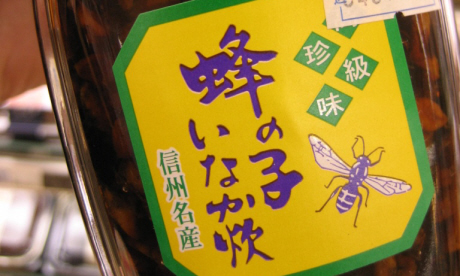
Experimental foodie or fussy eater? Whatever your tastes check out these top five strange foods from Japan. Whether you seek them out or avoid them is up to you
Hachinoko (bee and wasp larvae) is a popular delicacy in Nagano Prefecture, central Japan.
After being harvested from their nests (carefully, one would assume), they are cooked in a classic combination of soy sauce and sugar. This produces a slightly sweet, crumbly snack to nibble on between meals.
Omachi, a city in Nagano, is particularly famous for crackers made with a certain type of wasp called the 'digger wasp'. Locally know as 'jibachi senbei', they go down a treat with the old folks – who have formed an appreciation fan club for digger wasp treats.
It is said that the late Emperor Hirohito used to enjoy eating fried wasps served traditionally with boiled rice seasoned with sugar and soy sauce.
Suppon, or soft-shelled snapping turtles, have been eaten for centuries in Japan, and for much longer in China. These turtles are nutritionally rich and are often said to have healing and power-giving qualities.
Most parts of the turtle are eaten, except the hard part of the shell, leg bones, nails and bladder. Suppon are usually served in soup or stew, with a rich, light broth, typically made from soy sauce, sake and mirin (a rice wine – quite similar to sake).
The taste of the turtle meat is regularly compared to the dark meat of chicken, but really suppon tastes like suppon. So, if you're curious, you'll just have to try it.
Lots of people eat cows, right? But how many of you would eat a cow's tongue?
Well, gyutan (cow's tongue) is pretty popular in Japan, especially in yakiniku restaurants (essentially the same as a grill). It's not one for me and I've always politely declined – although I've been told it's delicious.
Originally from Sendai, gyutan is often served with rice, tail soup and pickles. However, if you order it in a yakiniku restaurant it is more likely to be served simply with salt, and may be called tanshio (tongue salt).
When a Japanese friend told me that back home in Nagano she liked to snack on grasshoppers, I thought something must have been lost in translation.
However, it soon became clear that she was referring to 'inago' – grasshoppers/locusts which are again, traditionally boiled in soy sauce and sugar. They make a very moreish dish, and their 'crunchy on the outside, juicy on the inside' texture certainly sounds... Intriguing.
Don't worry: while inago are sometimes served as bar snacks, you're unlikely to find them unless you stray way off the beaten track into rural areas of Nagano, Gunma or Yamagata Prefectures.
It's not that I demand my food should be cooked before I eat it (I'm quite partial to a bit of sashimi or sushi), but I do insist that what's on my plate is at least dead.
In the case of shiro no odorigui, these little critters are not only alive, they're dancing all over the place.
Well, not literally shaking-their-thang but 'odori-gui' means 'dancing eat' – and these fish are famous for wriggling, jiggling and squirming around your mouth before you swallow them down... Alive.
However, for all those daring diners – a word of warning. This is a rare dish and should you want to try eating shiro alive, you should make sure that you go to a reputable restaurant.
 Words: Ali Muskett
Words: Ali Muskett
Check out our Japan travel guide for more inspirational tips and articles... More
Time to return to Japan | News... More
A culinary tour of Japan: Travel the country for food 'so good, I found it hard to believe I was ingesting food' | Destinations... More
Check out our food and drinks blogs for more appetising dishes | Blogs... More
10 foods travellers may be forced to eat: would you try these? | Inspire me... More